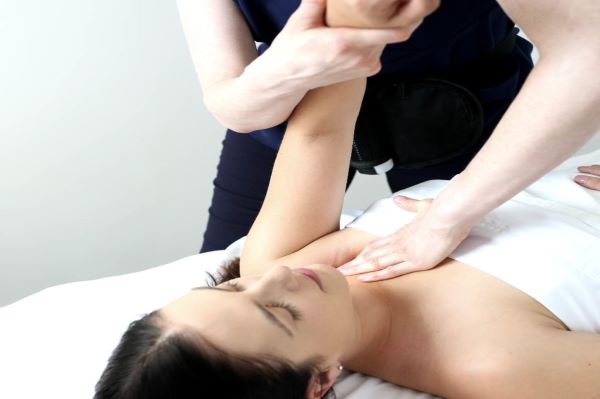
Building a Successful Massage Practice Specializing in Shoulder Care
May 23, 2023 11:15 amIf you’re a massage therapist looking to specialize in shoulder care, you’re targeting a crucial area that is prone to various conditions and injuries. The shoulder is a highly complex joint that consists of the glenohumeral joint, acromioclavicular joint, and scapulothoracic joint. Understanding the intricate anatomy, movement patterns, consequence of poor posture and misalignment of the humerus and the scapula in relation to the shoulder will help you provide effective treatment and establish a successful massage practice. Let’s explore some key aspects to consider.
Anatomy and Movement Patterns: Within the intricate shoulder region, the complex interplay of bones, joints, and muscles enables a remarkable range of motion and functional capabilities. Comprising the clavicle, scapula, and humerus, this region showcases not only three pivotal joints but also a myriad of muscles responsible for its intricate movements. The glenohumeral joint, a marvel of articular construction, manifests as a ball-and-socket joint where the rounded head of the humerus dynamically interfaces with the shallow socket of the scapula. This anatomical arrangement permits an extensive array of movements and positions, essential for the remarkable mobility of the shoulder. Meanwhile, the acromioclavicular joint assumes the role of connecting the clavicle to the acromion process of the scapula, solidifying the structural integrity of this region. Additionally, the scapulothoracic joint, a remarkable element of the shoulder’s functional architecture, elucidates the coordinated movement of the scapula along the thoracic wall. Together, these complex anatomical structures and their intricate relationships pave the way for the astonishing versatility and biomechanical elegance observed in the shoulder’s movements. (Source: American Academy of Orthopaedic Surgeons)
Common Shoulder Conditions: The shoulder, being subject to the demands of rapid movements, repetitive stress, and the inexorable effects of wear and tear, is susceptible to a panoply of diverse and often vexing conditions. Among the frequently encountered afflictions are rotator cuff tendinitis, a distressing inflammation of the tendons surrounding the shoulder joint; shoulder impingement syndrome, a bothersome condition characterized by compression of the structures within the shoulder joint; frozen shoulder, also known as adhesive capsulitis, an enigmatic and incapacitating ailment marked by the formation of adhesions and consequent restriction of joint mobility; and bursitis, an inflammatory process affecting the fluid-filled sacs (bursae) that facilitate smooth joint movement. These conditions can engender a range of distressing symptoms, including pain, diminished range of motion, and discomfort. Acquiring a comprehensive understanding of these conditions not only enables an accurate assessment of the underlying pathology but also fosters meticulous treatment planning, optimizing the prospects for successful intervention and patient recovery. (Source: National Institute of Arthritis and Musculoskeletal and Skin Diseases)
Assessing the Joint: Before initiating treatment, it is essential to conduct a thorough assessment of the shoulder joint. Evaluate the client’s range of motion, muscle strength, and any signs of inflammation or instability. Assessing the joint before and after treatment allows you to track progress and make any necessary modifications to your treatment plan.
Developing a Comprehensive Treatment Plan: A successful massage practice requires a well-rounded and comprehensive treatment plan. Each client’s needs will vary, so tailoring your approach to their specific condition and goals is vital. Utilize evidence-based practice guidelines and draw upon your knowledge of anatomy, kinesiology, and assessment techniques to inform your treatment decisions. This ensures that your interventions are based on sound principles and have a higher likelihood of achieving positive outcomes. (Source: Massage Therapy Foundation)
Importance of Accurate Charting: Accurate and detailed charting is essential for maintaining client records and tracking progress over time. Documenting assessments, treatment plans, and outcomes provides a valuable reference for future sessions and allows for effective communication with other healthcare professionals. Accurate charting ensures continuity of care and facilitates informed decision-making.
Trustworthy Referrals: Building relationships with other healthcare professionals is crucial in establishing your massage practice specializing in shoulder care. Collaborate with physicians, physical therapists, and orthopedic specialists who can provide trustworthy referrals to your practice. Mutual trust and positive outcomes will contribute to the growth and success of your business.
Conclusion: Specializing in shoulder care as a massage therapist requires a deep understanding of the shoulder’s complex anatomy, movement patterns, and common conditions. By developing comprehensive treatment plans, conducting thorough assessments, charting accurately, and collaborating with other healthcare professionals, you can build a successful massage practice. Continuously enhance your knowledge and skills to provide effective care and help your clients improve their shoulder function and quality of life.
Sources:
American Academy of Orthopaedic Surgeons: www.aaos.org
National Institute of Arthritis and Musculoskeletal and Skin Diseases: www.niams.nih.gov/health-topics/shoulder-injuries-and-disorders
Massage Therapy Foundation: www.massagetherapyfoundation.org
Tags: specialize in the shoulderCategorised in: Blog, SFH Kinetic Massage, SFH Orthopedic Massage
This post was written by Linda Hoppe
Comments are closed here.